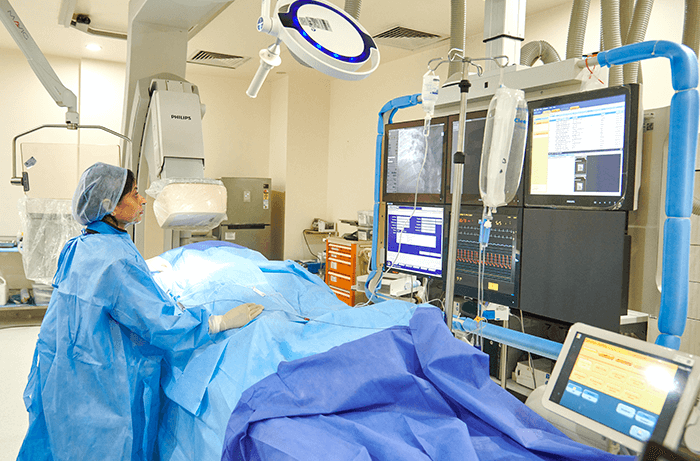×
Select Your Country
 International
International

×
Select Your Country
 International
International


Complex coronary interventions (Left main, bifurcation, chronic total occlusion, Rotablation) Our heart is a complex organ that poses quite a few challenges to the medical field in diagnosing and treating certain compelling disorders. Coronary artery disease is the narrowing or blockage of the coronary arteries caused by atherosclerosis, which is the build-up of cholesterol, fatty and inflammatory deposits called plaque on the inner walls of the arteries that restrict blood flow to the heart. Without adequate blood flow, the heart becomes starved of oxygen and vital nutrients it needs to work properly. Some of the more complicated coronary artery diseases are those of the left main coronary artery, bifurcation blockage, chronic total occlusion and Rotablation.
Left Main Coronary Artery disease (LMCA) The left main coronary artery provides the primary source of blood flow to the left ventricle of the heart. In some, it gets blocked with plaque consisting fats, cholesterol, calcium and other substances building up inside the coronary artery. If the blockage is severe, you can get angina or chest pain, shortness of breath, and, in some cases, a heart attack too. However, a few path-breaking interventions are making a difference to those suffering from coronary artery disease. Intravascular ultrasound (IVUS) is frequently used to diagnose left main coronary stenosis or blockage.
Solutions for LMCA Disease Percutaneous coronary intervention (PCI) technique with stents is a less invasive procedure to treat LMCA disease. A coronary artery stent, which is often placed during angioplasty, is a small, metal mesh tube that expands once inside a coronary artery. Its purpose is to prevent the artery from becoming blocked again. A drug-eluting stent is coated with medicine to help prevent the artery from closing. Where angioplasty doesn’t work to clear the blockages, Coronary Artery Bypass Graft is the most effective of treatments. It is however, an open heart procedure that requires hospitalisation. But, it improves your quality of life, reduces angina and other Coronary Heart Disease symptoms, improves the pumping action of your heart if it has been damaged by a heart attack, lowers the risk of a heart attack and also improves your chance of survival.
Coronary Bifurcation lesion Coronary bifurcations remain one of the most challenging lesions in interventional cardiology. The narrowing or stenosis, in a main coronary artery and an adjoining side-branch vessel is called a bifurcation blockage or bifurcation lesion.
Solutions for Coronary Bifurcation The two primary interventional strategies commonly used are the systematic implantation of a stent in both the main vessel and the side branch vessel, and the provisional T-stent. In addition to the usual guide wire that is placed in the main vessel, the cardiac interventionist places a second guide wire through the stent in the main vessel and performs a side-by-side or "kissing balloon" dilatation after the first stent has been placed.
Chronic Total Occlusion (CTO) This is a severe form of coronary artery disease where there is complete blockage in the artery. If the total coronary occlusion is more than three months old, it is called a chronic total occlusion.
Solutions for CTO Due to the nature of this high risk heart condition, it takes years of experties to excel in performing these complex interventions. At Manipal Hospitals, our accomplished interventional cardiologists have advanced training in performing complex coronary interventions, including angioplasty and stenting, to unclog arteries. Here, our experts adopt the retrograde approach in which total coronary blockages are accessed from collateral blood vessels. Collateral blood vessels are new blood vessels that form to reroute blood flow around a blockage, and develop when the severity of a blockage increases. The procedure involves the insertion of two hollow thin tubes called catheters, from an artery in the wrist or groin up to the heart. A contrast dye is injected into the coronary arteries. X-ray images trace the dye as it flows through the arteries, helping to pinpoint blockages. Then, the cardiologist inserts a very fine guide wire into the blocked artery from the front (antegrade) and back (retrograde). The balloon inside the artery is inflated to open it up and permanent drug-eluting stents (small mesh coils) are inserted to open the artery and release medication over time to prevent future plaque build-up. This highly complex, minimally invasive procedure can greatly lower heart attack risk associated with CTO.
Rotablation This procedure which is very similar to the cardiac angiogram, uses a Rotablator, a miniature diamond studded drill, to treat calcified lesions prior to conducting an angioplasty. Here, a catheter is inserted into the right radial artery in your wrist or in the right femoral artery in your groin. When the catheter and wire are in the right position, your cardiologist will use the Rotablator to pulverise the plaque to bits, before inflating a balloon and stent within this area.